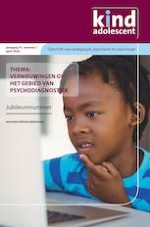01-02-2020 | Artikelen
De IDT: een nieuwe, interactieve tekentest voor wederkerig gedrag bij kinderen met autisme
Gepubliceerd in: Kind en adolescent | Uitgave 1/2020
Log in om toegang te krijgenSamenvatting
Inleiding
Methode
De kwaliteit van wederkerig gedrag werd gemeten bij in totaal 392 jeugdigen (6–20 jaar) waarvan 334 (225 met en 109 zonder ASS) met de onderzoeker tekenden op papier en 58 (32 met en 26 zonder ASS) op een tablet met touchscreen.
Resultaten
Deelnemers met ASS lieten op de papieren versie van de IDT, onafhankelijk van leeftijd, geslacht en verbale intelligentie, minder frequent wederkerig gedrag zien dan deelnemers zonder ASS. Op de digitale versie (DIDT) vertoonden deelnemers met ASS eveneens minder wederkerigheid. Wederkerigheidsscores op de DIDT waren onafhankelijk van leeftijd en geslacht, maar correleerden positief met verbale intelligentie.
Conclusies
Zowel de papieren als de digitale versie van de IDT differentieerde tussen jeugdigen met en zonder ASS. Autistische kenmerken blijken een consistent negatief effect te hebben op wederkerig gedrag. De digitale versie lijkt gevoelig voor autisme maar ook enigszins voor verbaal cognitief niveau. Onvolkomenheden van en enige beperkingen in de hardware hebben waarschijnlijk de resultaten met de DIDT beïnvloed.
